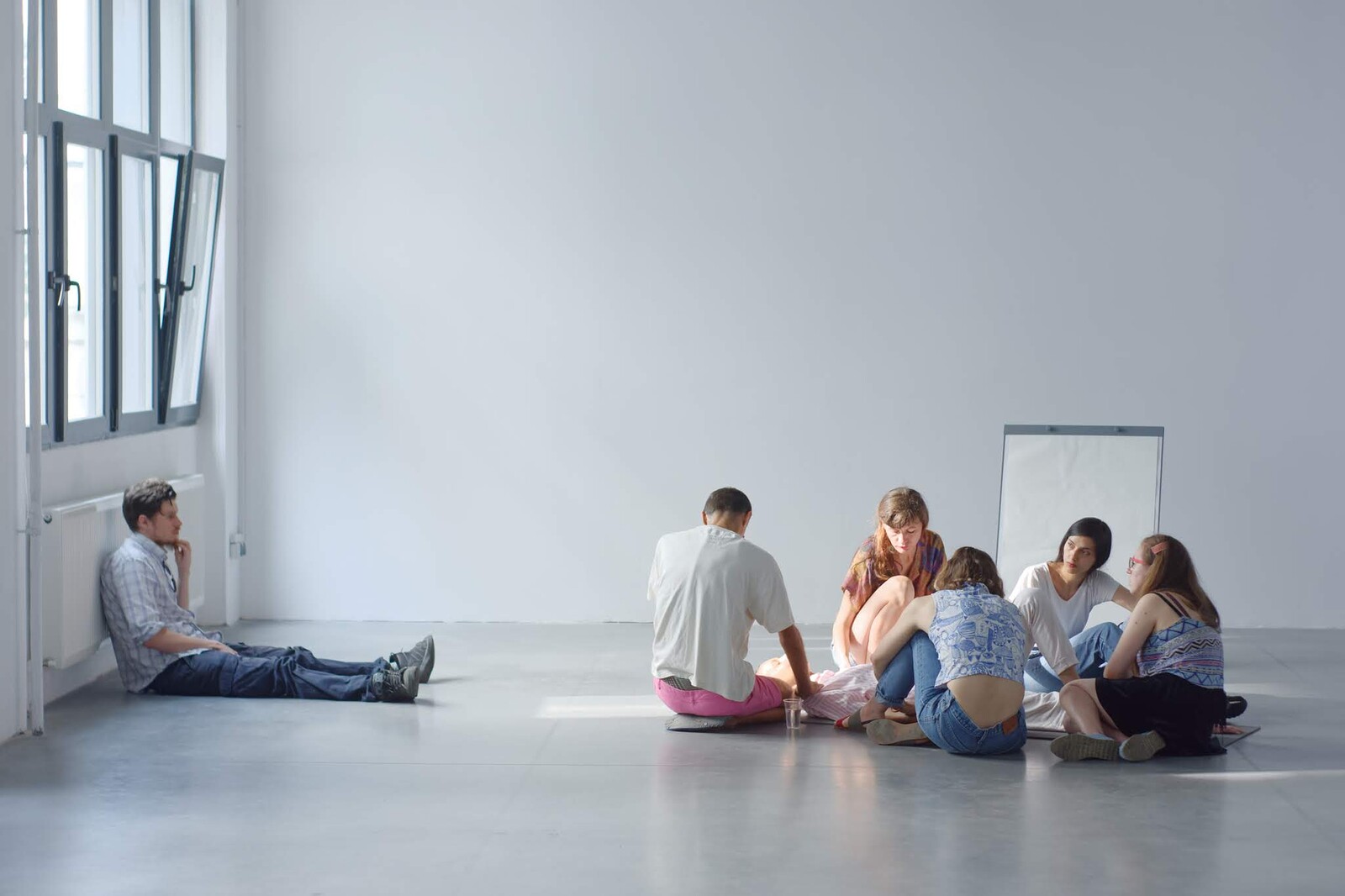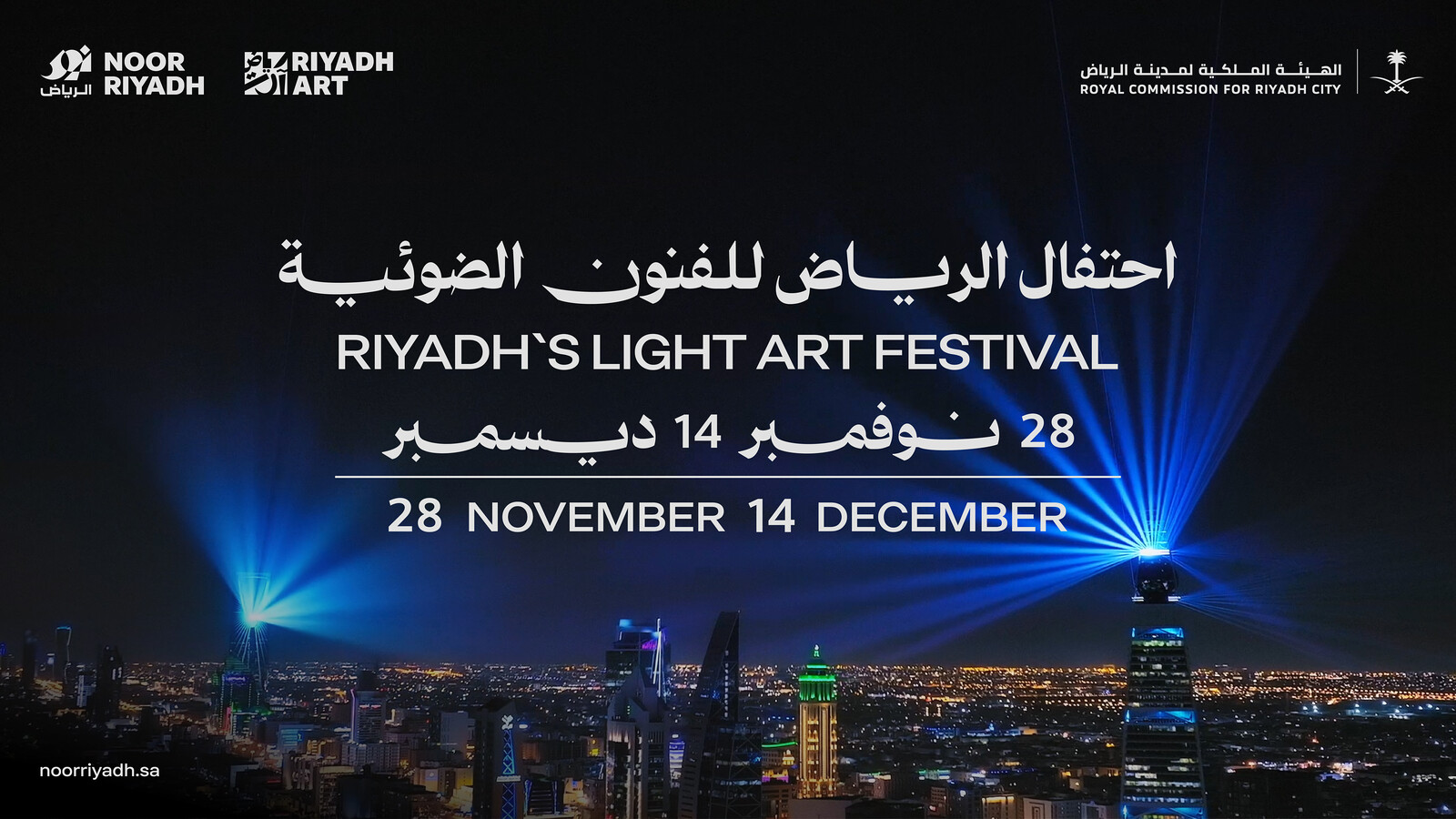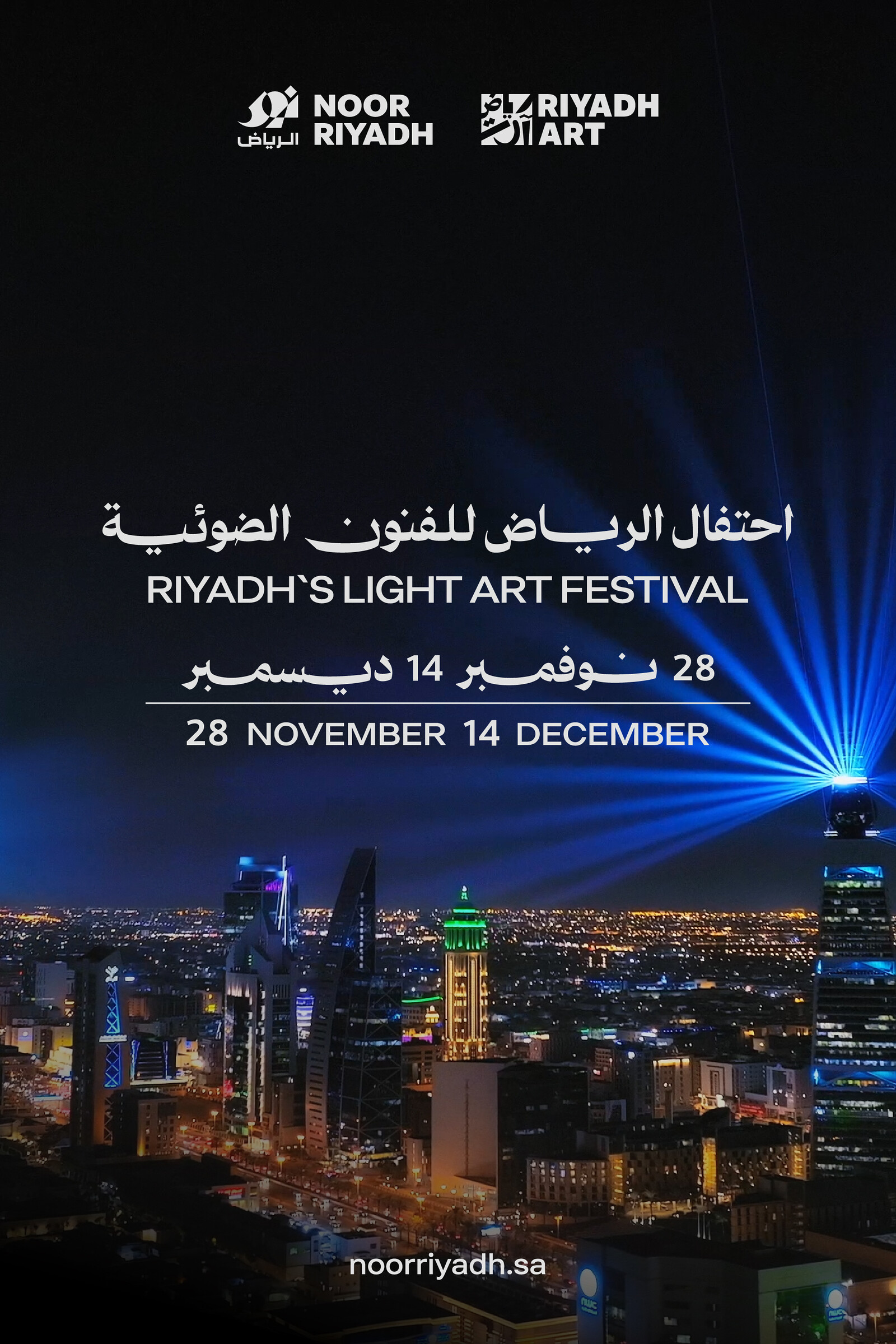This piece started as a written interview with Alina, conducted by Garett Strickland. While answering Garett’s first question, Alina found herself writing a full essay. —Ed.
And so, sharpening the tip of my pencil with the intellect’s razor, preparing my darkness with poison, comparing the blackness of the color with melancholy itself—because what can be more worthy of such an image?—I decided to paint something black on black in the hope that my work would be something elegant and at the same time convenient. Of all the colors that the eye of man can judge, there is none closer to nothingness, none that escapes human sight more swiftly, none that so greatly deceives the faculty of seeing, being indistinguishable from the darkness, which, as the ancients liked to say, comes into existence once the sun—flame, eye, and father of the universe—disappears, spreading all over, like the darkest black of nothingness. As the black-colored human science and the black tableau of my capacities are by no means distinguishable, but, on the contrary, to put it more clearly, precisely because the tableau of my capacities is exactly like the darkness, what can I paint on a canvas of the same color? Oh, intolerable calamity! Mixing the darkness of nothingness with the night of human science, what kind of hue do we think we can yield? Not a black one? In the same way, when the blackness of my all-too-miserable science, based on perception, is mixed with the aging poison of my tongue and painted on the darkest canvas, what kind of face do I think will be shown to me?
—Dimitrie Cantemir (1673–1723), Metaphysics: Sacrosanctae Scientie Indepingibilis Imago
Garett Strickland: I’m interested in how your work manages to articulate a concept—often quite mystical or abstract—into the body by way of performance/event. I’d align much of your textual work within a tradition of metaphysical speculation, which tends often to soar beyond embodiment, and so to bridge its formulations into, for example, the movement arts. It strikes me as something very unique and a bit tricky. Could you elaborate a bit on that process, its entry and/or exit points?
Alina Popa: It’s true that my work in the past years, especially in the Unsorcery project with Florin Flueras, has been preoccupied with the performative potential of abstract concepts (Life Programming, Artworlds, Second Body, Dead Thinking, Eternal Feeding, End Dream, and Black Hyperbox), with their potential effects upon the organization of mental space, life, and body practices, upon the production of art and of what, when, and where a performance/art work is. It’s also important that in the process of coming up with the concepts that have further oriented our artistic work, we have not only read, discussed, and thought, but have cultivated specific somatic practices inspired by spiritual exercises, contemporary dance, awareness through movement, and what Foucault called technologies of the self and Agamben called forms-of-life. The concepts came out of the hybrid doing-thinking.
Our idea was that if life and movement have already been captured by the neoliberal apparatus, and if thought itself is movement, providing orientations in the space of the mind and being deeply connected to one’s life-form and body arrangements, then they have to be provided with different choreographies than those enforced by default. Not only have we noticed that there are life-forms imposed if one’s practices are left unchoreographed, but there is also a standard form of thought and action when it comes to overcoming capitalism. One of the reasons behind the Unsorcery project was the mental saturation with the same thought movements performed by the leftist mind: being against, exercising criticism/critique, deconstructing, etc. Not only capitalism but also its enemies seemed to have been captured in default thought forms.
At the same time, not only has the body’s spatial arrangement been produced by modernity’s concepts (see the chapter “The Taming of the Rebel Body” in Silvia Federici’s book Caliban and the Witch). Even what the 1960s thought of as the freedom of the body, as the rebellion of the body against its historical taming, has been turned into a commodity—when subjectivity, with its potential for dissent, infinite freedom, desire for communication and social bonds, and with its individual marks of differentiation, started to be commodified and successfully sold under post-Fordist rule. This is how, for example, the concept Second Body came into being, as a quest for a body that is not free as in the 1960s, not only deconstructed as in the seminal choreographic work of the 1990s, not only made into a provider of liveness and memory for the visitor to a contemporary art museum in the blooming experience economy of the 2000s.
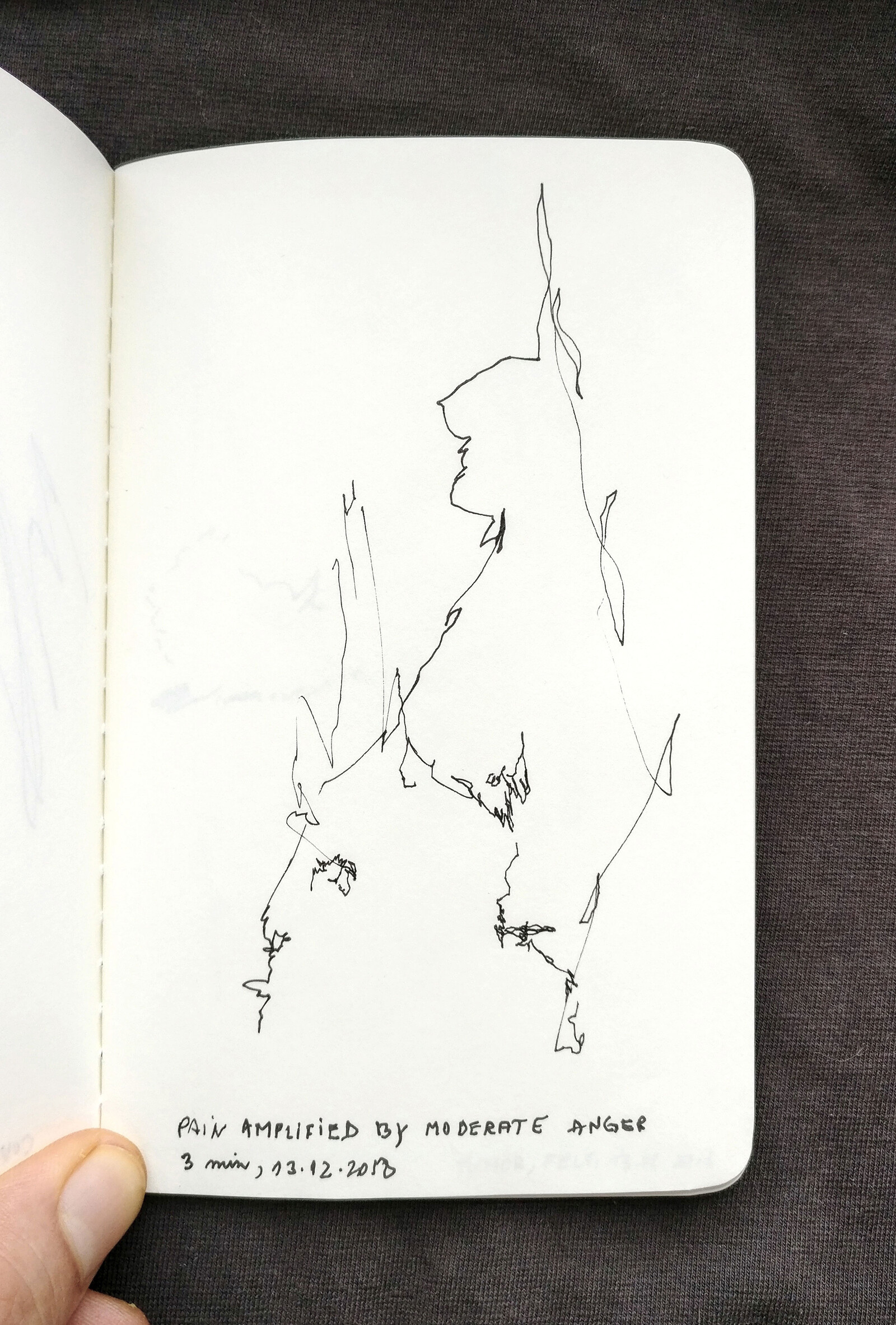
Alina Popa, Drawings Made with Closed Eyes, Notebook on the Chest, December 2018-January 2019.
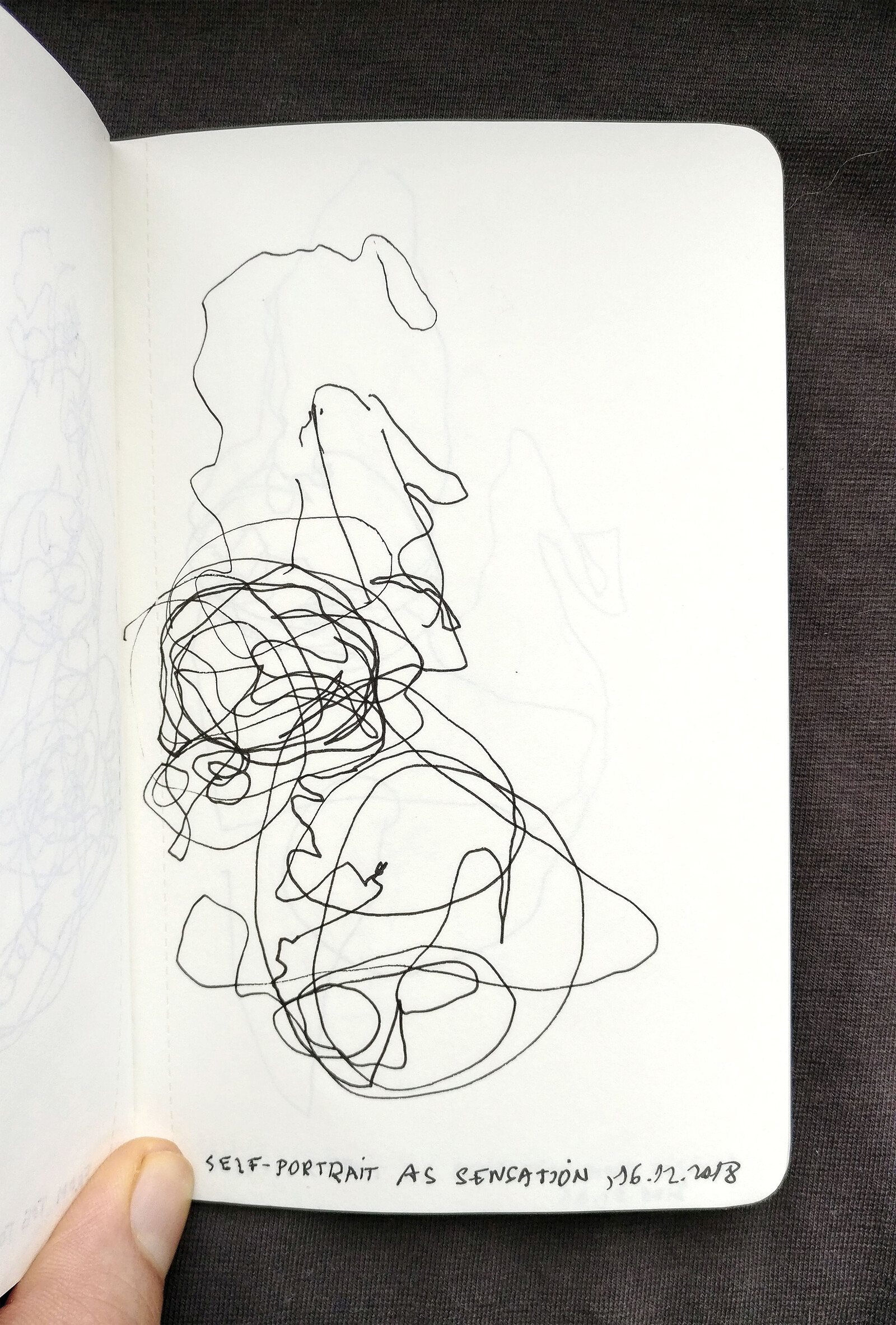
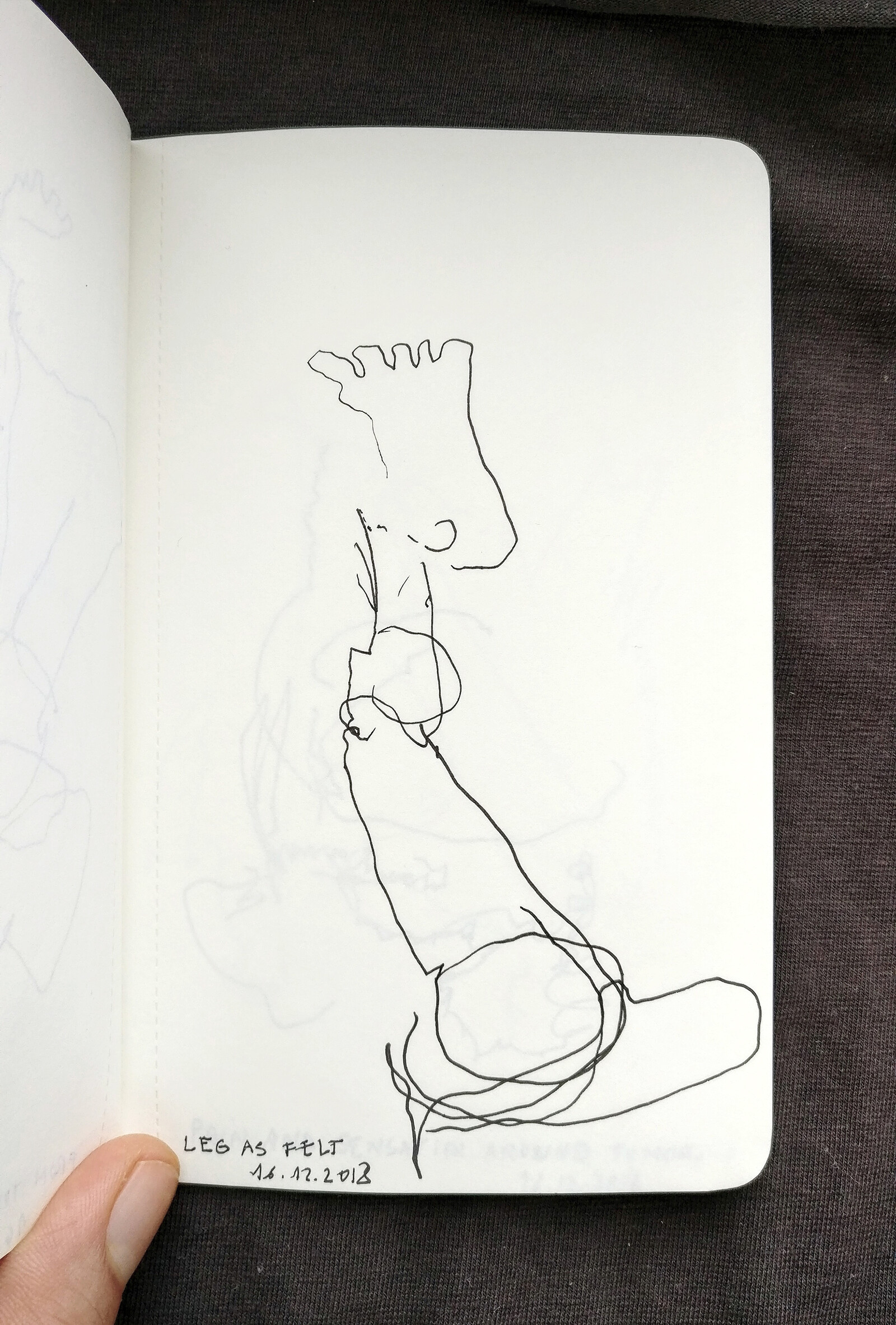

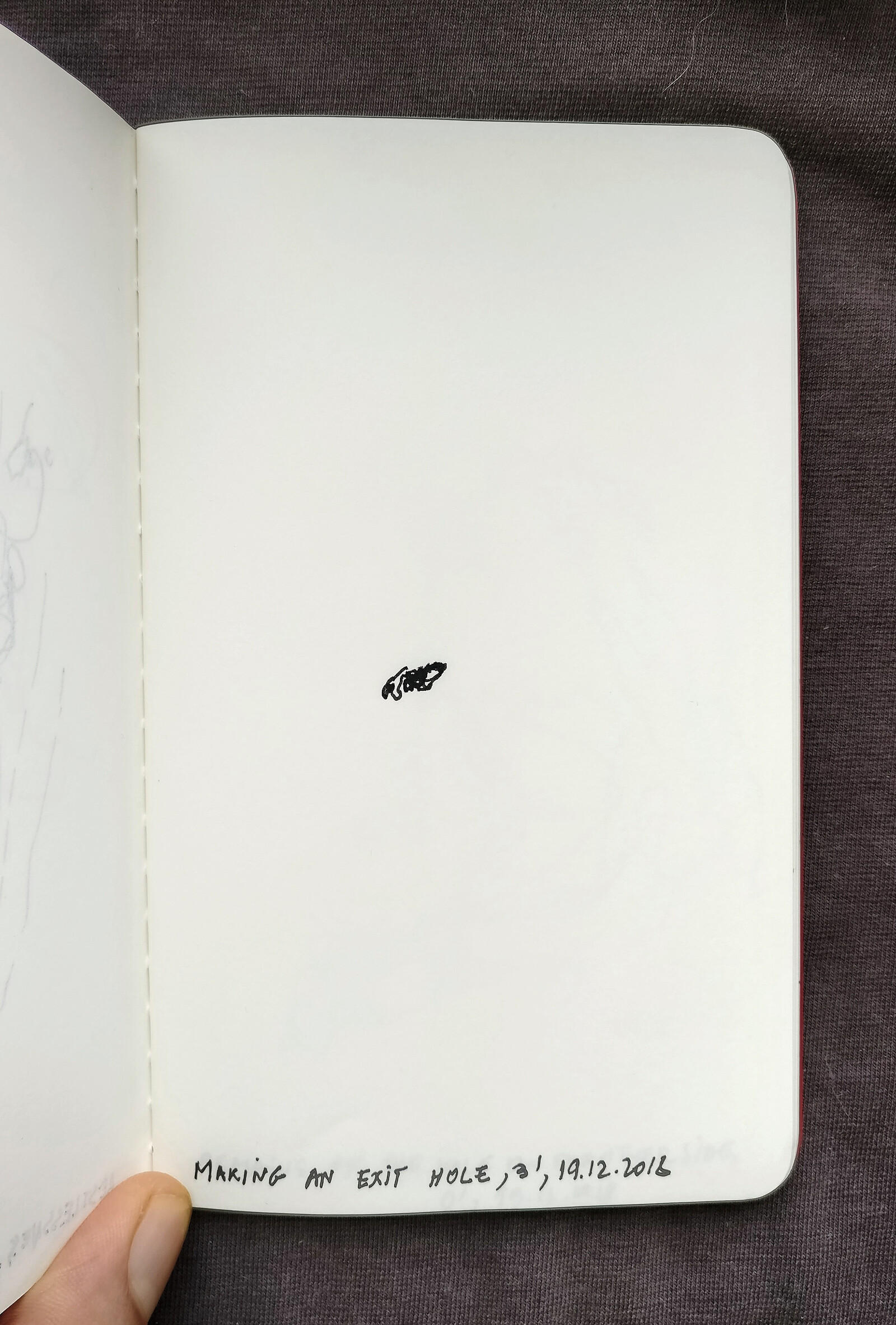
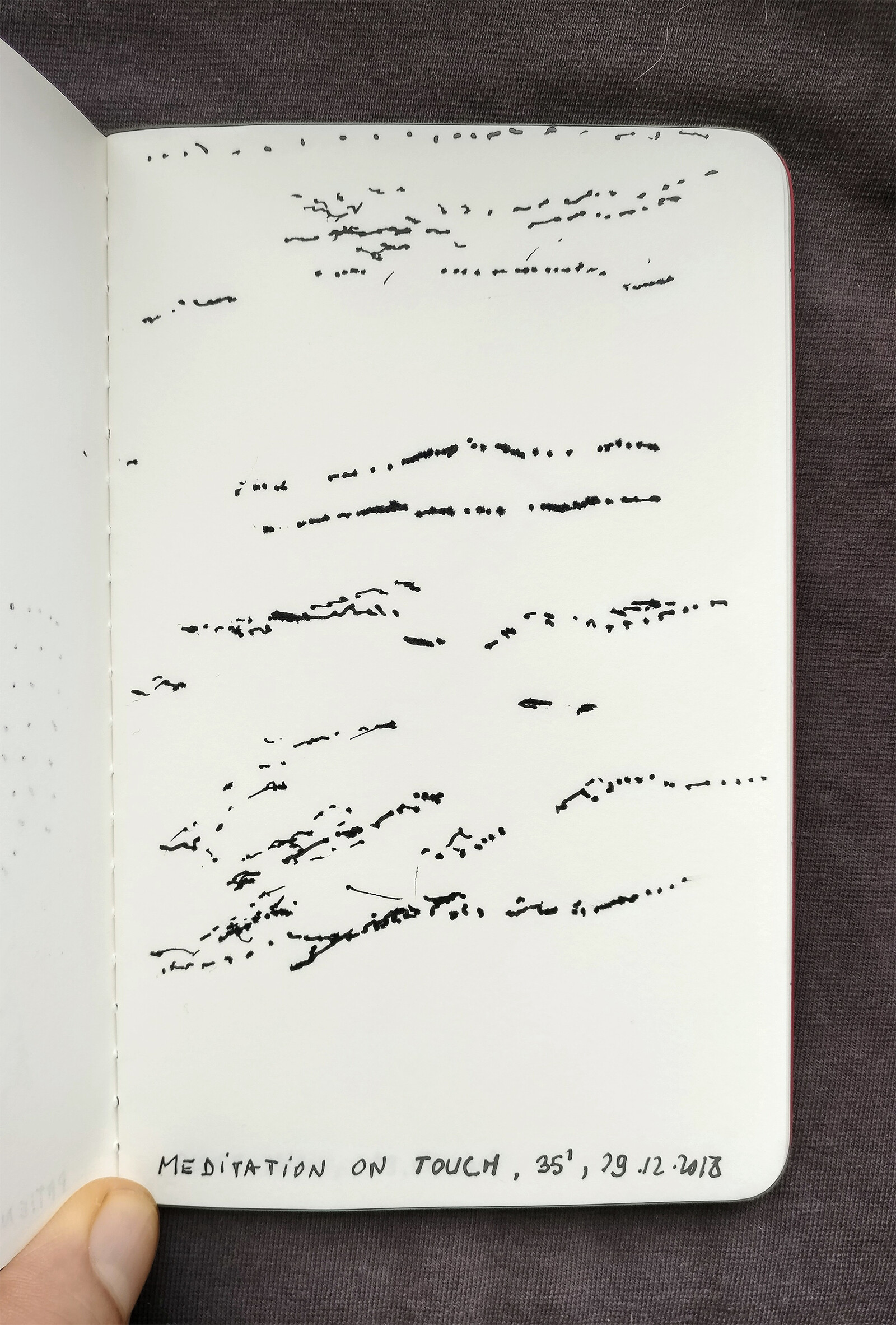
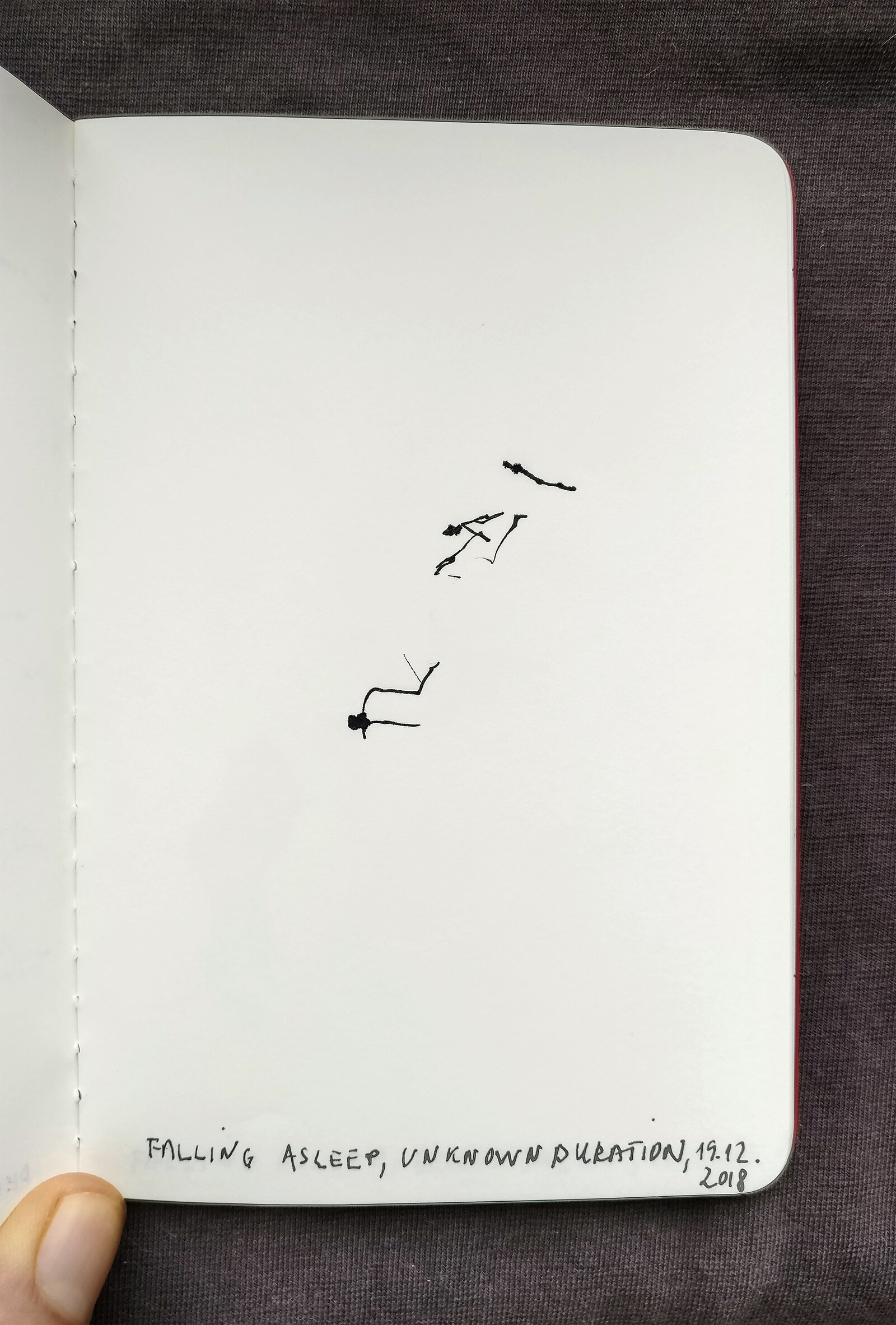
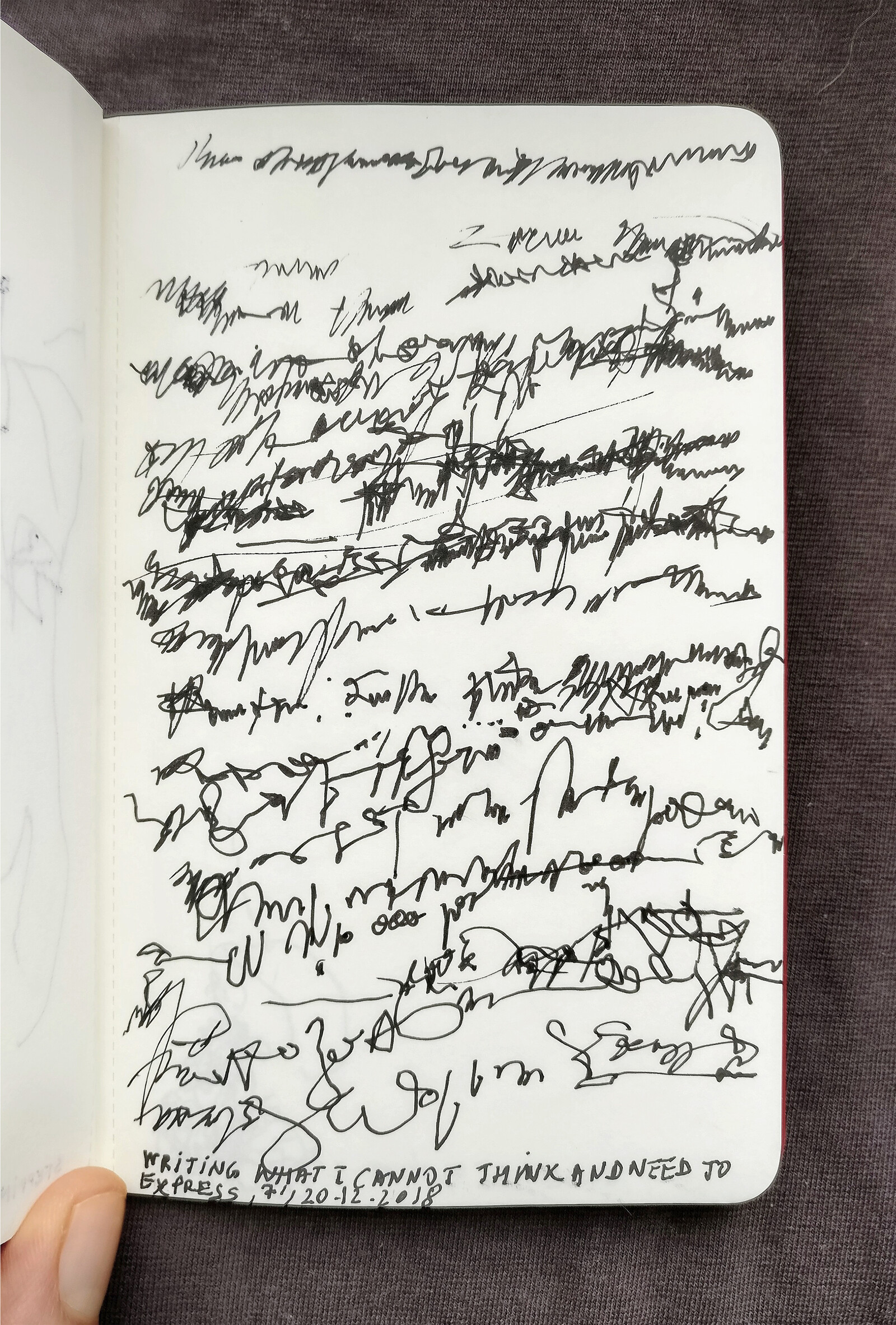
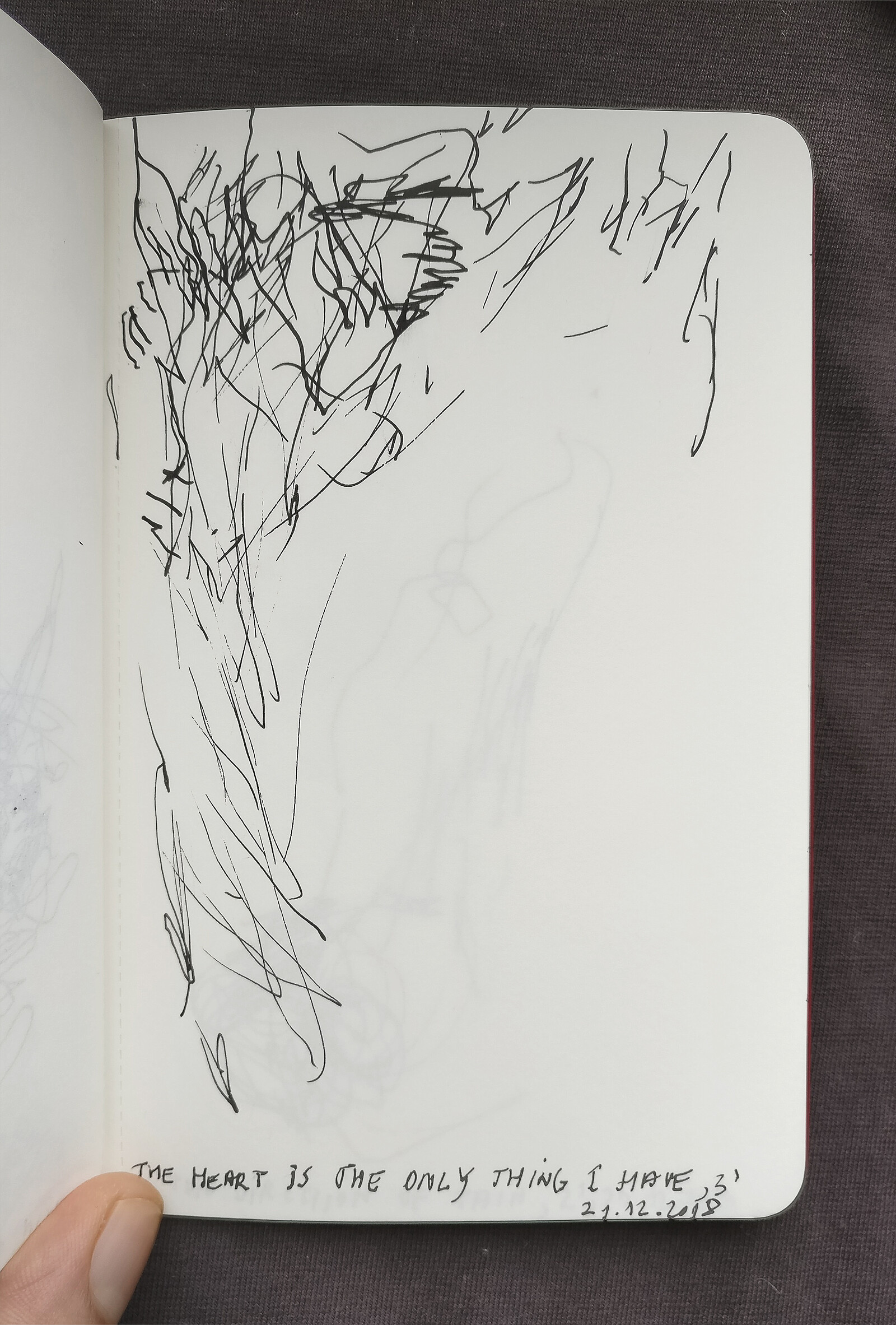
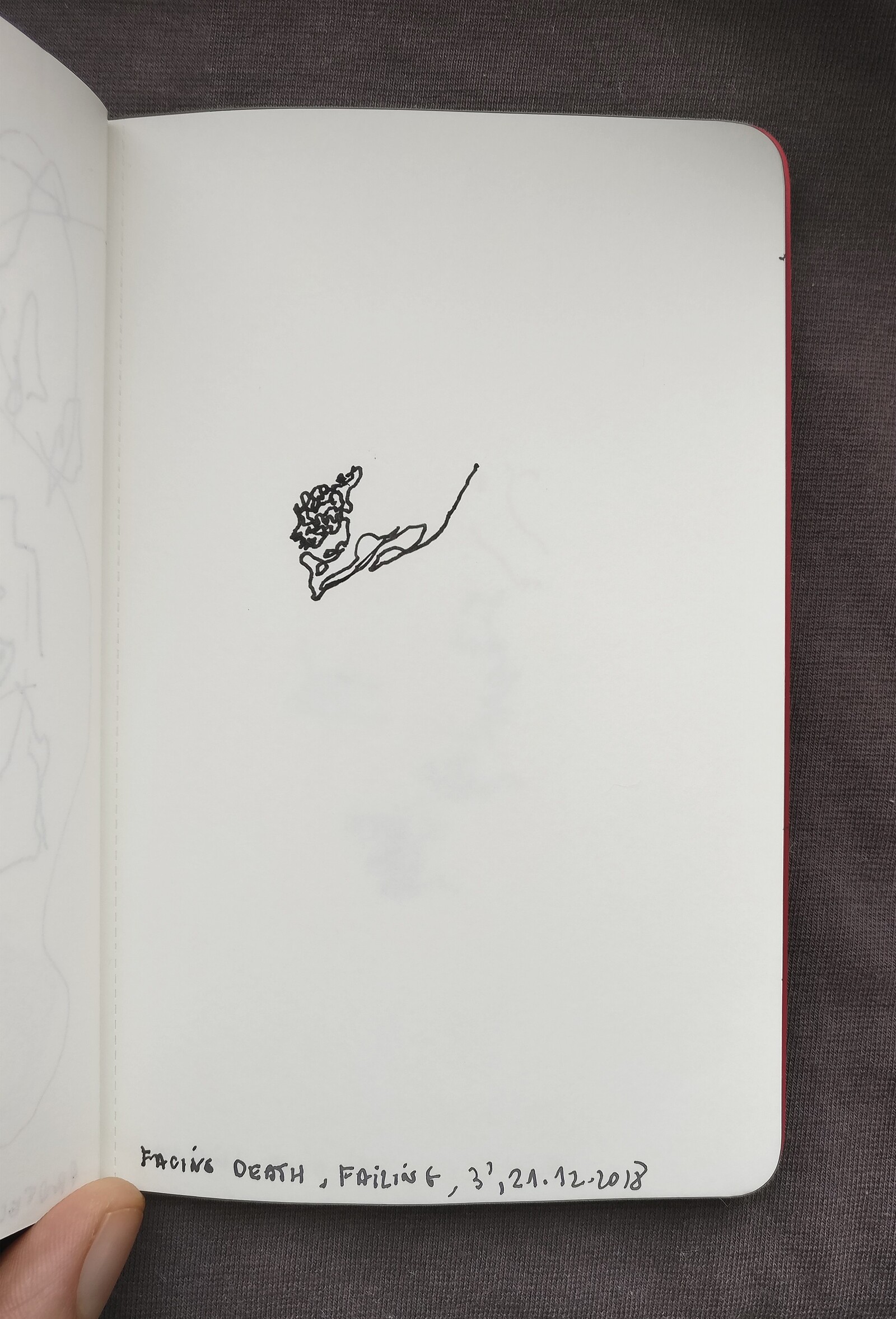
Alina Popa, Drawings Made with Closed Eyes, Notebook on the Chest, December 2018-January 2019.
I guess it remains to find out how that body can show itself, and how it can show its own production as “another” through a concept to whose making it itself has contributed. It has to be a continuous process, a sort of navigation in and out of determinations, floating on the edge of identity, being no one without consolidating the “no one” into an identifiable category, but keeping its negation alive. What we are now working on is the implementation of the idea of an artwork as artworld—which would be able to include more than just a body appearing on stage or in a museum, something other than the usual performative act. We are interested to see if there is a way to establish in the format of an artwork something which is as complex and immaterial as a world, made of bodies, bodies produced by life-forms and idiosyncratic concepts that these bodies themselves have helped to articulate.
I also think that the conflict between concepts and the body fully disappears if one understands—at a political level—that the body has not always been as it is today in Western societies, but has been produced by modernity’s concepts, while its liberations have been incorporated into neoliberal concepts—concepts which in turn produce contemporary bodies. This is one of the reasons why I have been interested in Brazilian anthropology—to have a glimpse of a concept of the body, and a concept of the concept that is outside modernity’s reach. Interestingly, the work of Eduardo Viveiros de Castro, following Amazonian worldsense, presents thought with an altogether different concept of the concept—one closer to art’s concept of the concept, which is not necessarily an immaterial idea, but it can be an aesthetic complex, that unfolds either in space (a landscape of images, objects, words, etc.) or in time (for example, a performance whose object is the rhythm of the changing affective atmospheres in a given context). Not only the generic but also a complex of particulars can be a concept—this is what both contemporary art and premodern Amazonians affirm.
One can also mitigate the conflictual duality abstract concept–material body on a philosophical level. We can look at the content of a philosopher’s work in conjunction with her biography, her life-form. It is mainly this form that shapes the trajectory of thought. There is always a meta-history, a particular structure of consciousness that has driven minds into certain philosophical systems or even against systematicity. The environment is perhaps the main force bending thinking and behavior in different directions. As Viveiros de Castro put it at a philosophy conference in Paris: “Thinking in Rio is not the same as thinking in Paris.” In relation to this, but also to the question of metaphysics, I have in mind two examples, one at the foundation of critical philosophy, Kant (1724–1804), and the other one, Cantemir (1673–1723), unknown by Western canons, a Moldavian polymath trained in Constantinople, a very exciting precritical mind.
If we were to compare these two and their work on metaphysics to painters (at least to artists trained as painters), Kant is maybe Duchamp, investigating the conditions under which metaphysics (art) is possible at all, and Dimitrie Cantemir is certainly Malevich avant la lettre, as he himself explained in his Metaphysics (see the epigraph to this essay). We need to understand that Kant slept very little, thought prayer was useless, was certain that there are planets in the universe inhabited by fully rational beings, and would sometimes stamp his feet in order to better ground himself. Cantemir composed music, prayed, had visions and out-of-body experiences, dreamed of God, and cried, melodramatically lamenting his human limitation in providing knowledge with an accurate image of the Absolute. In a way, the precritical Cantemir went even deeper than Kant, deconstructing the Western mind’s infatuated pathos for totalization. Kant’s is a fixation on the possible, on trust in reason as one’s given capacity to throw the human tentacle beyond perception, through pure reason, further away into the world as it is, the world-without-us—yet this fixation is humbled by the inaccessible Absolute, as he himself is forced to admit. Cantemir is haunted by the impossible, by his own humiliation as a body incapable of extracting itself out of the world to see it as it is, incapable of looking at God from the outside in. It is the Prussian order and the Reformation’s rational rigor versus Constantinople’s Orthodox mysticism and the Eastern aesthetic dimension. No doubt, as Malevich and Duchamp, both (should) have gained a critical edge in the history of their profession.
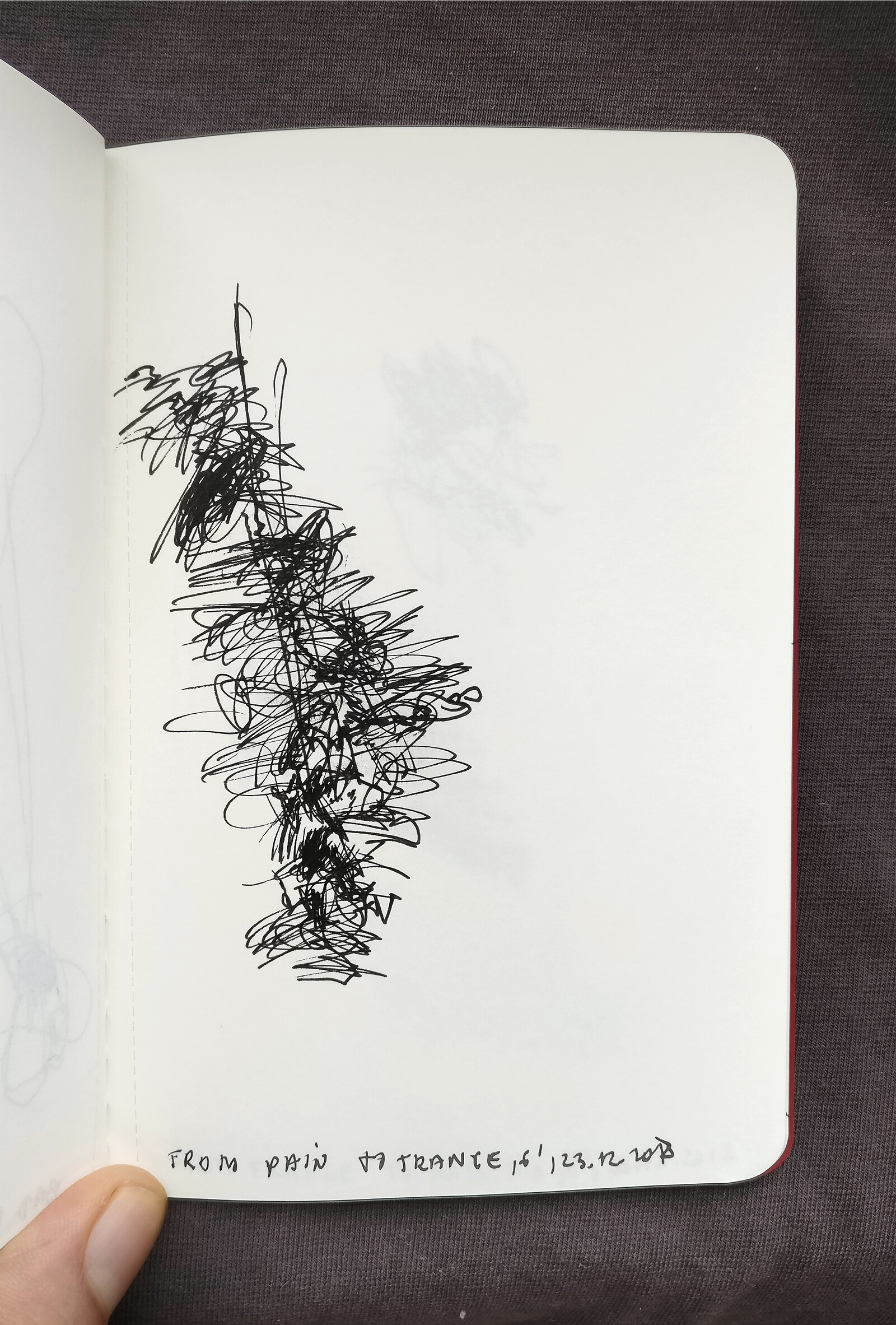
Alina Popa, Drawings Made with Closed Eyes, Notebook on the Chest, December 2018-January 2019.
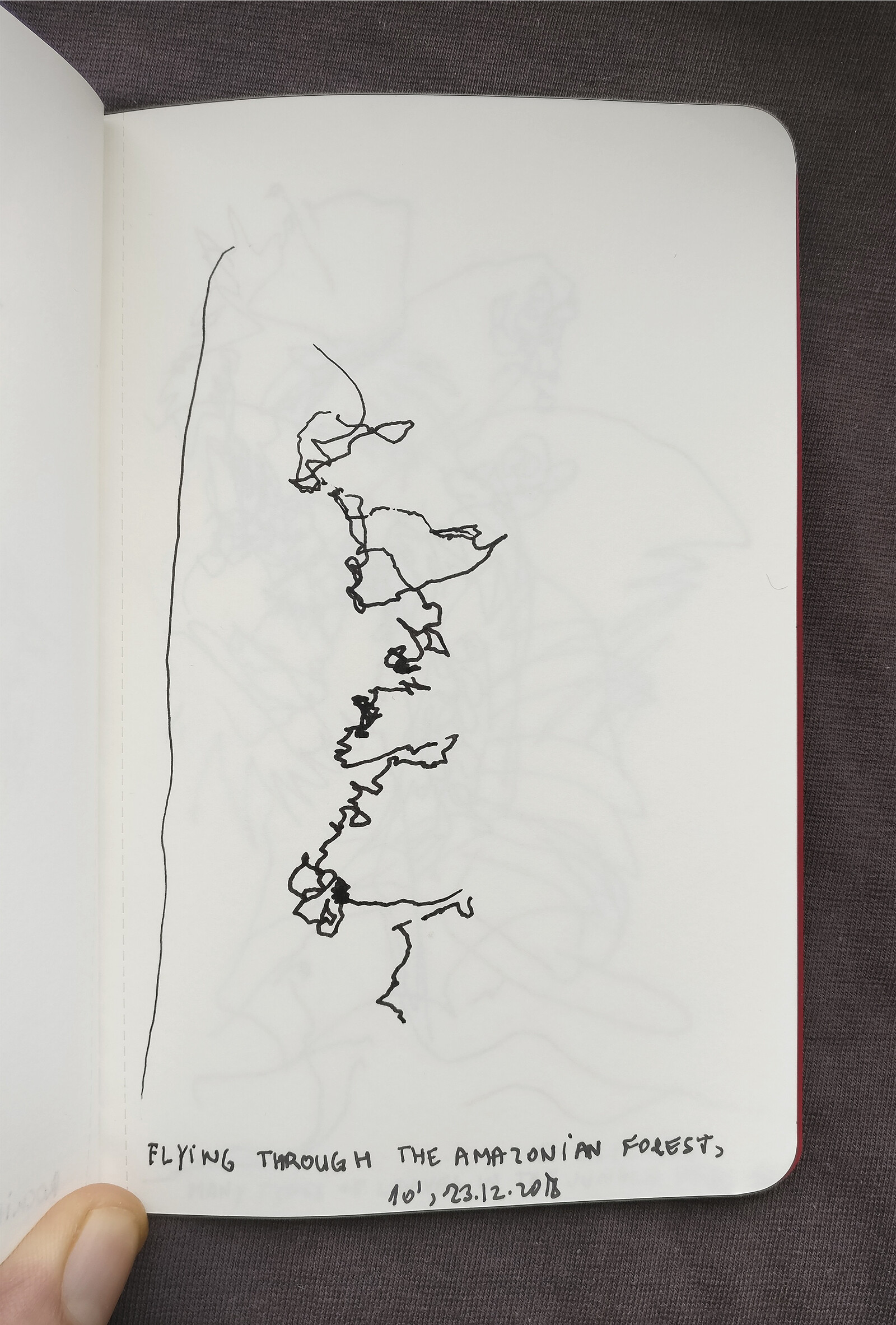

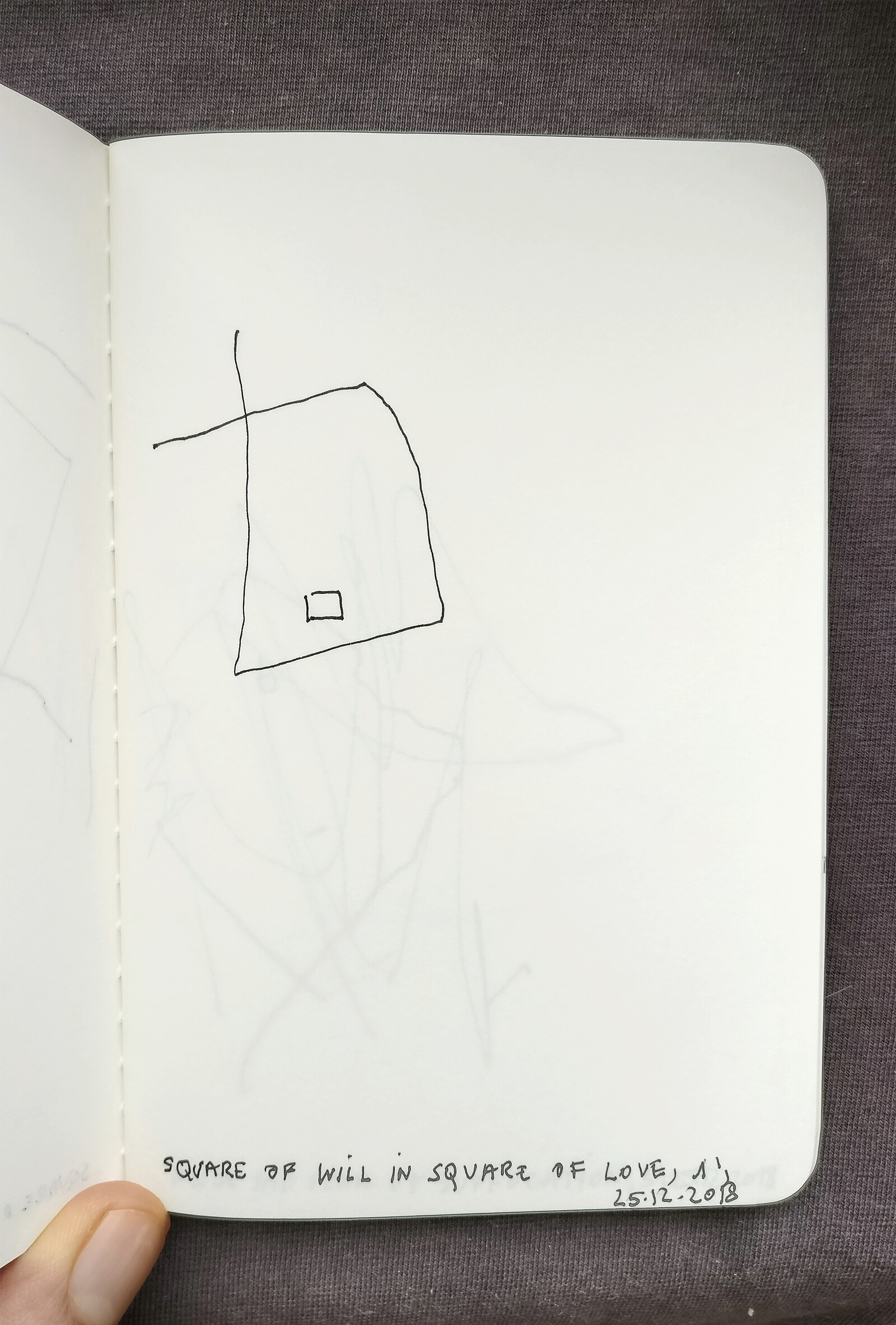
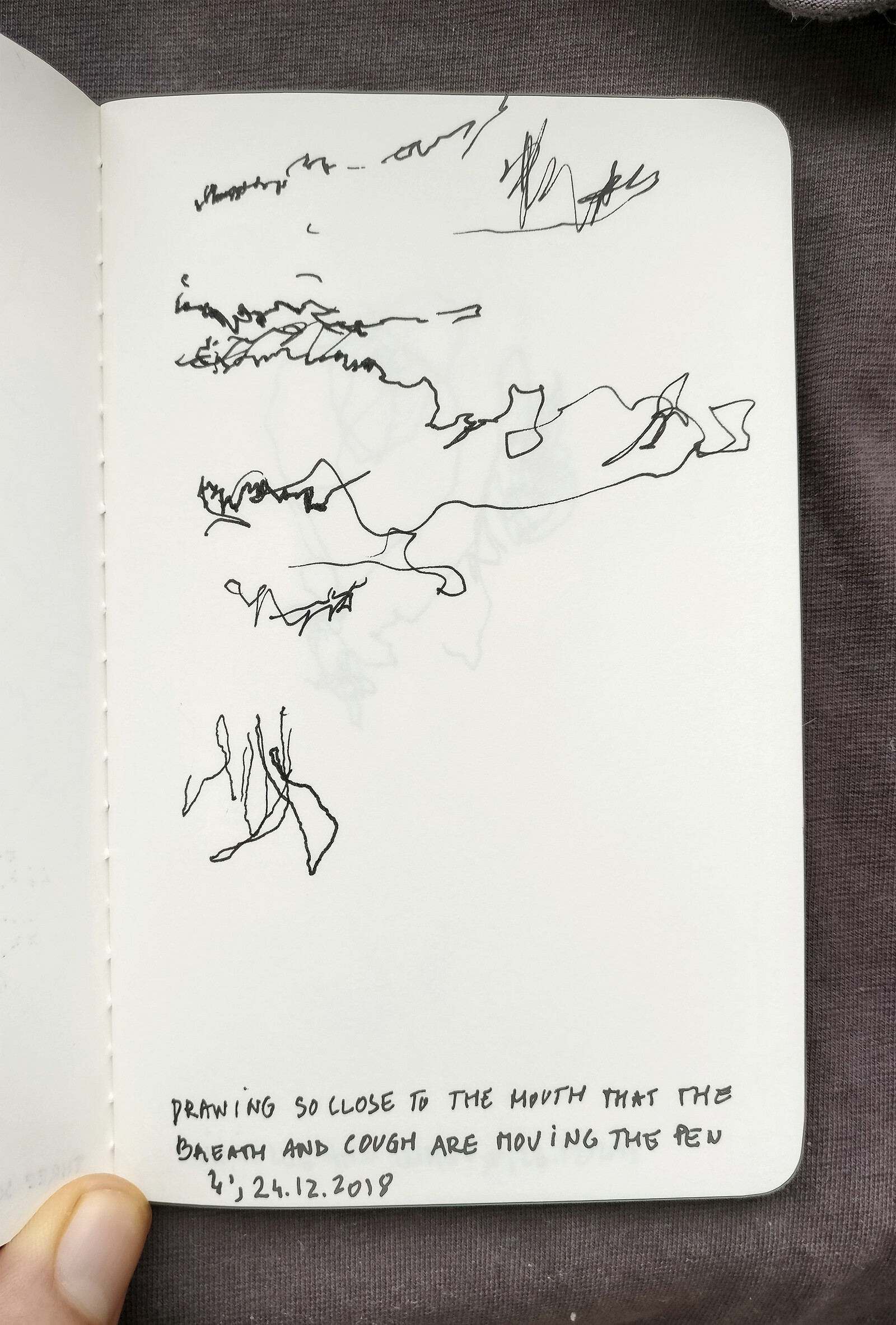
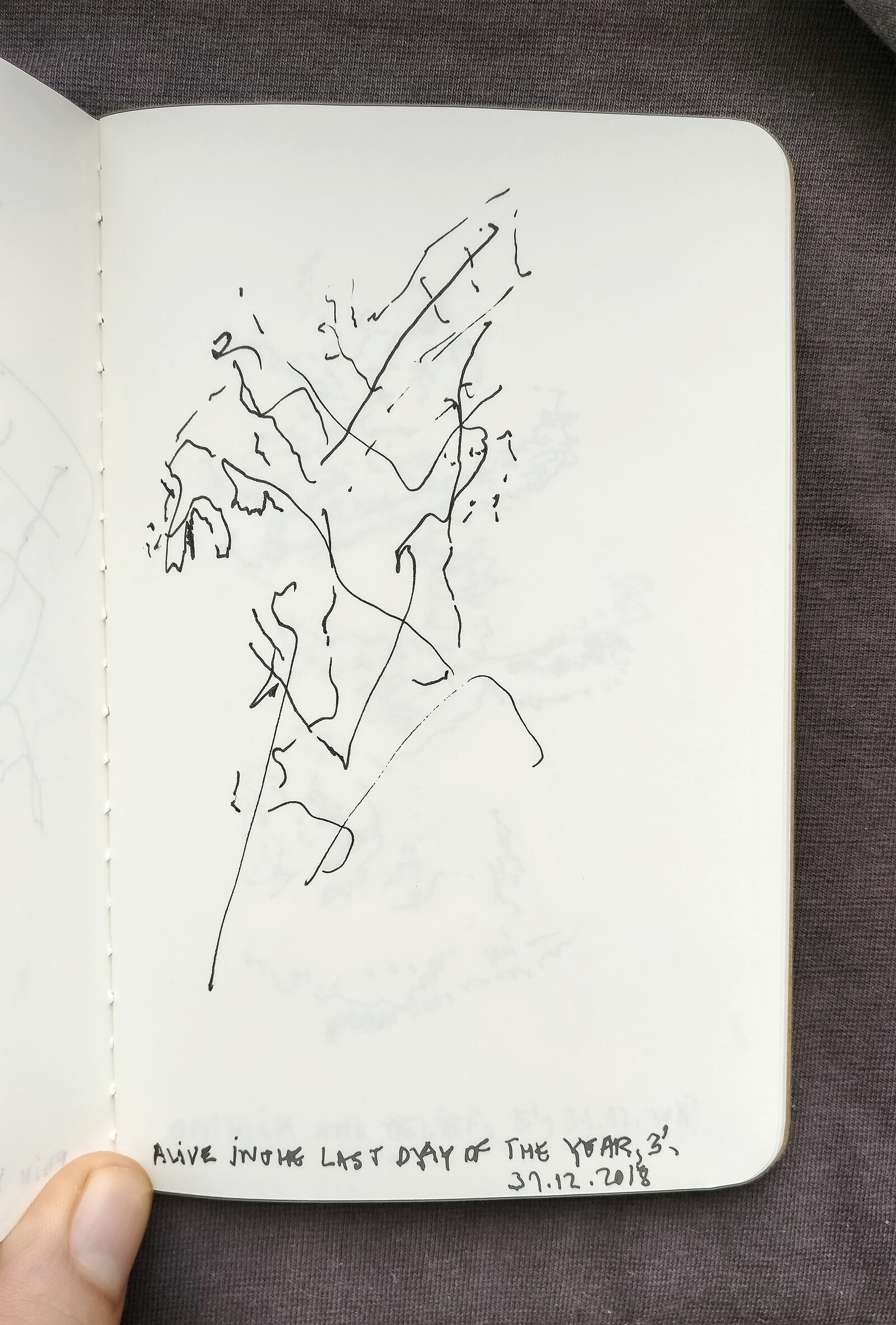
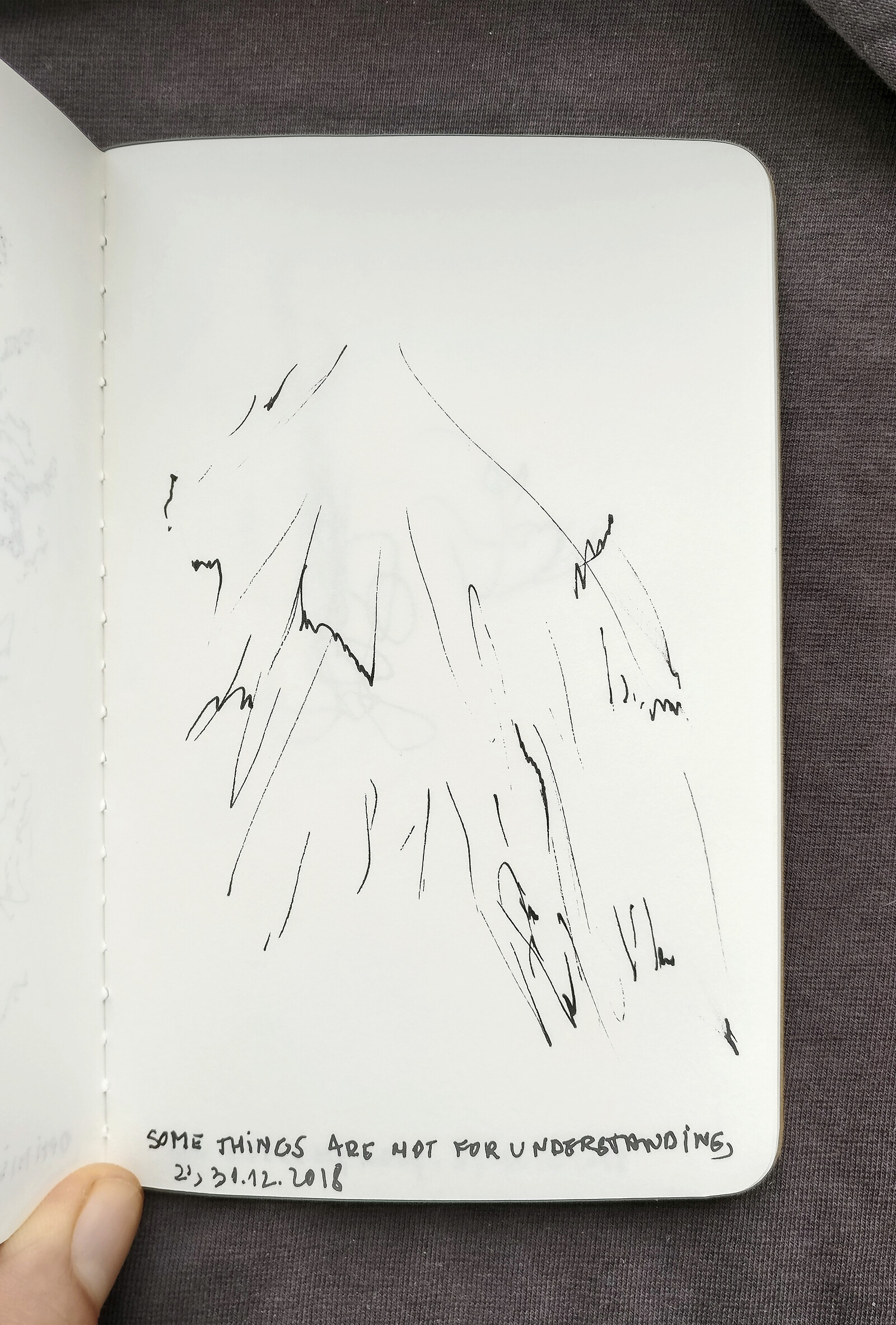
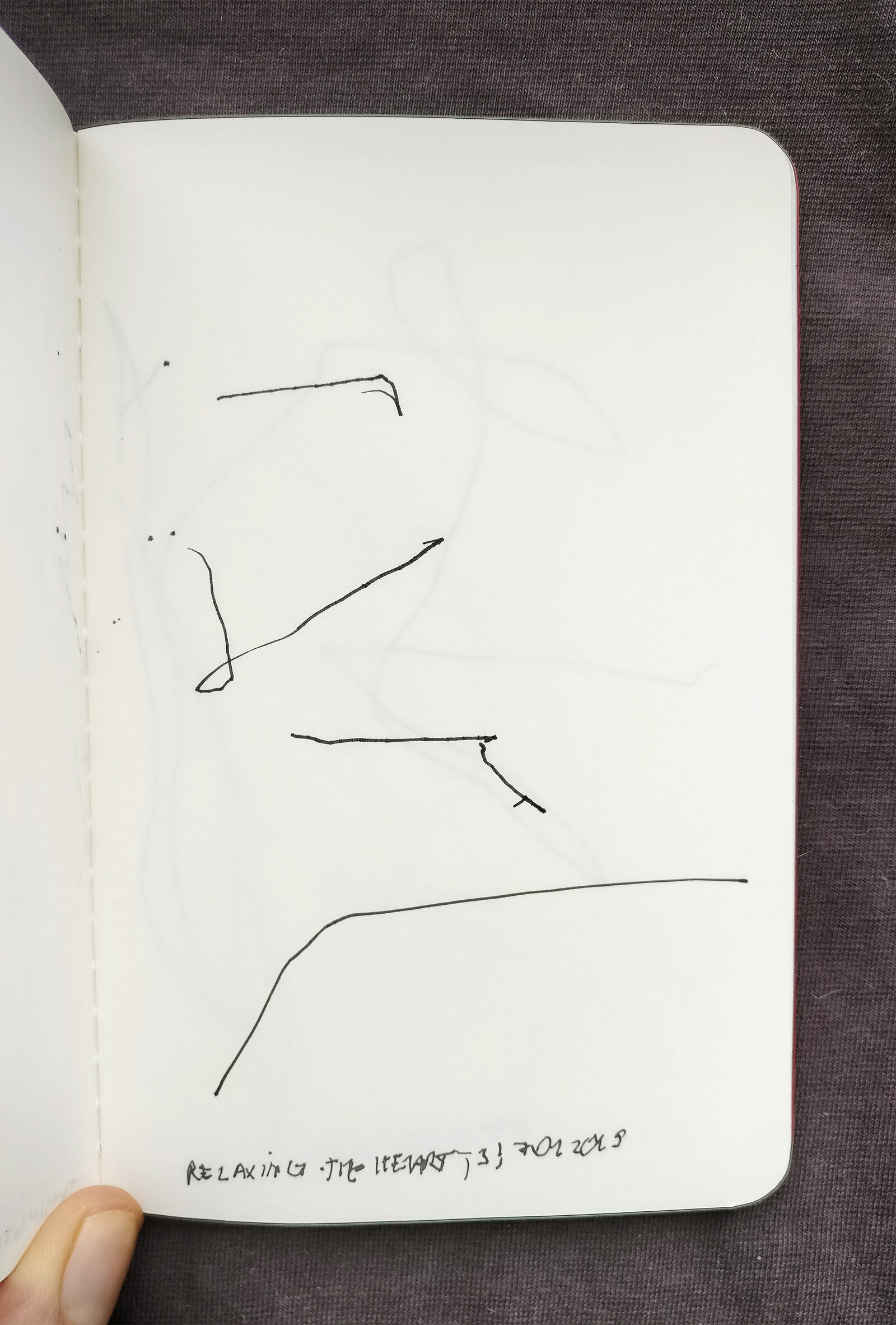

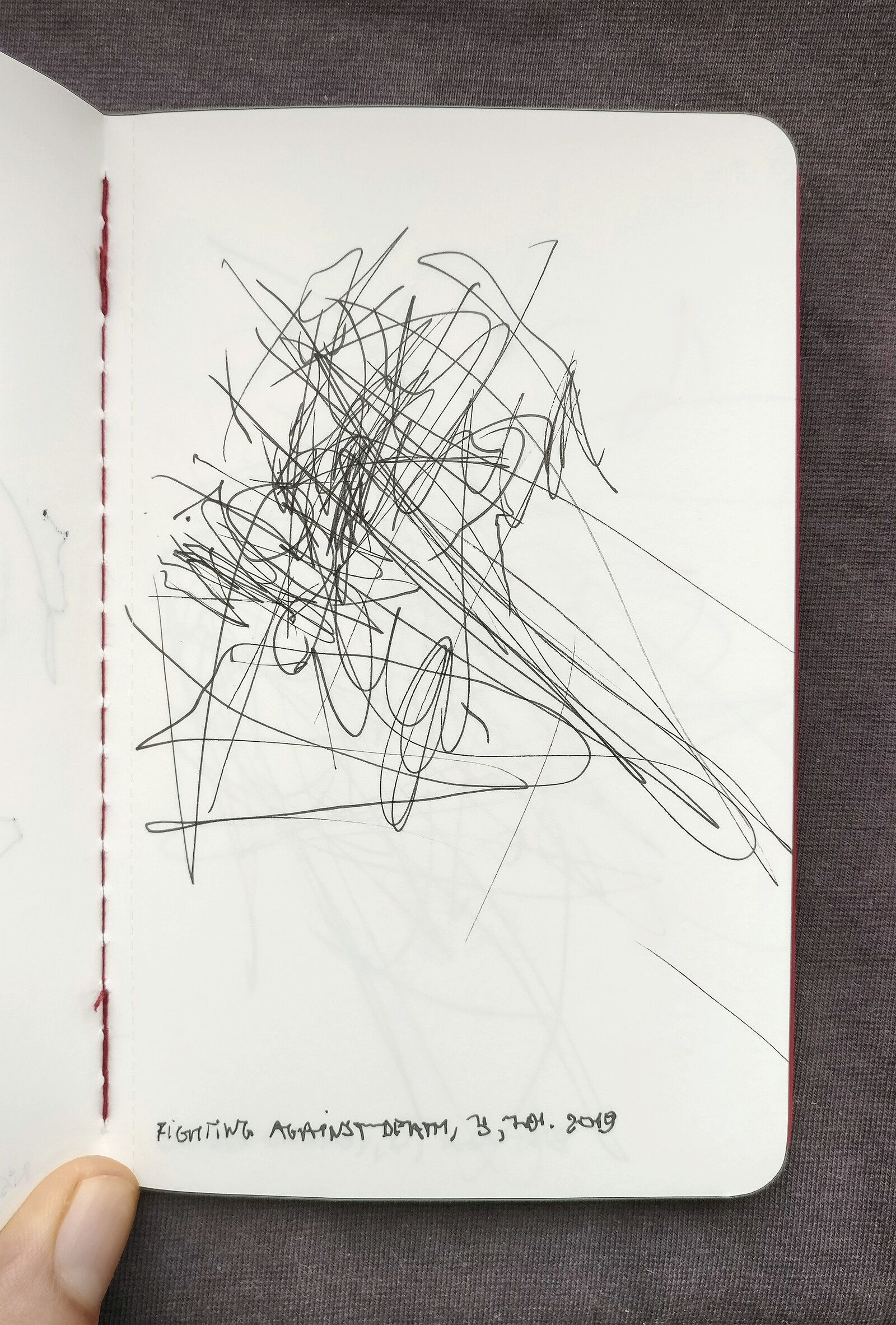
Alina Popa, Drawings Made with Closed Eyes, Notebook on the Chest, December 2018-January 2019.
In his precritical reasoning, Cantemir anticipates the modernist gesture of Malevich, who painted the black square, black on black, a mystical gesture (his black square was to replace the Orthodox icon), whose precritical incapacity for figuration discovers critically the support of the canvas, the meta-painting, the conditions of possibility of painting. And with this apparently naive statement, painting goes beyond its concept, turning into a gesture—art travels into its own foundations. We also see from the quote that I tried to translate for you at the beginning of this interview that Cantemir focuses aesthetically on the initial gesture of any metaphysician—and this is where he finds Black Square. He lingers in this moment of interior lament, of profound human humiliation, of out-of-body experience, of trance, of desire. He speaks of the aesthetics of the human desire to create, which is the same as to know, to cry, which is the same as to reason, to make a coherent tableau of the whole, to abstract, which is the same as to become God. As one of his visions shows, the face of God is impossible to fix in a single image. The face of the old man that appears in his dream as God, or metaphysics, constantly changes, like Philip K. Dick’s scramble suit, yielding no conceivable image. The initial chapters of Cantemir’s book on metaphysics could alone turn philosophy into melodrama, and art and aesthetics into the scary ghost of knowledge. Imagine a philosophy book written together with a detailed description of the depression that led to its writing, of human lament over one’s own limitations, of the misery of attempting to understand!
Of course, I am more impressed by the Eastern mystical moment of beginning to think, all the more so because the consciousness that naively dramatized such confessions remains hidden from accepted philosophical canons. Yet Kant’s example can be equally interesting, and helps me illustrate here the bifurcated relationship of performance art and metaphysics that I am interested in. To reach Kant, as I said, we must go through Duchamp. Two years after Malevich paints Black Square, Duchamp establishes the readymade in making his Fountain. The readymade is a whole apparatus. It states that an object of the world put in the institution of art, the museum, becomes art—and it is with this gesture that art becomes a performative proposition. It is now art itself that can say: “This is art.” And so art becomes the producer of its own concept, a modern meta-machine par excellence. Art produces its own metaphysics, without much Cantemirian lament. What does this have to do with Kant? Kant provides metaphysics with its own metaphysics, and this is where the link to Duchamp becomes apparent. They both dig into the conditions of possibility, into the frame of a context. While Cantemir, and even Malevich, provides methods for the process of individual creation, Kant and Duchamp rather deal with the level of interpretation. In philosophy, as in art, both are generative.
As you can see, I have opened two levels on which the question of the body can be linked to metaphysical problematics. The first one regards the process of creation (Cantemir’s laments) and the other one the level of reception, of interpretation (Kant’s coldness). The first is about how you do art (naively, in excess, holistically, with your body) and the second about where and when you do it (smart, strategic, alienating, in the institution/art world). Of course, the two are interconnected, if we think about Duchamp’s obsession with form-of-life and Malevich’s own overturning of the concept of art.
In the process of creation, to reach what is not available directly through the senses, or through immediate understanding, one needs to perform practices that enhance or enlarge the spectrum of both perception and reason. Gabriel Catren writes beautifully about this in his essay “Pleromatica,” published in Black Hyperbox, the book that Florin and I edited, published by PUNCH last year—and you [Garett] are also part of it. He explains how Kant ignored Cantemir’s insights—that precritical practices can actually enhance the workings of a critical mind. We can enter metaphysics more deeply than Kant had thought—and working with the body, with one’s organization of life, employing aesthetics alongside conceptual production, are all indispensable for this purpose. To tap into the unknown, into what is out there, into what is beyond the available reach of the senses and reason (let’s call this a metaphysical preoccupation), which are themselves biologically and culturally legislated, there is methodological work to do.
This is where my interest in metaphysics comes in. It is more an interest around its access and the impossibility of its access—with the whole aesthetic interior maelstrom that this can generate, à la Cantemir. I am preoccupied with developing performative practices, both somatic and discursive, that give form to the invisible, that give gravity to the immaterial. I have already mentioned technologies of the self and form-of-life as performative methods in the process of creation. In the last year, being also in a process of healing after a major health issue, I have used the occasion of being more isolated from the rapidly spinning art world to trim life and to work on the structure, on discipline, on all the practices behind the product. I am working on the immateriality of immateriality—since the artistic products of my solo work were immaterial anyway (though sometimes the practices that I do can include materiality, such as drawing and small-scale painting).
There is a therapy that I do called You Are—I am doing this in performance situations as well. I am lying on the floor asking the audience to offer me touch therapy. My body, heavy on the ground, my mind, lightly wandering, I set the situation of a lecture, of a first contact, of therapy, of an immaterial dance of thoughts held to the present by the material gravity of the setup. When I am home, I am interested in assigning a time frame to each practice. An intention can even give form to empty time. To give you an example, one healing practice called The Invisible Clinic is just the intention of going to a “fictional” or immaterial, empty clinic to be worked on by invisible forces. You have to do all the protocols, set a time, a duration, go with the intention, prepare mentally and then, while you really are in the clinic, let go of your body, will, and reason, trusting that at the end of the session you will be repaired. I think this would be even stronger as a communal empty space where the patient-audience can go and get better.
The latter is a practice that is actually equally productive in the process of creation, but it works on the frame, on the preconditions for any clinic to be effective, to be performative, that is, to act and heal the body. The Clinic is an “artworld” that will be organized in the Romanian countryside this summer with guest artists or other people interested in participating. The Clinic is in turn part of a more general artistic framework I have created with Florin Flueras, “Artworlds.” Within these artworlds we are developing the concept of Life Programming, under which all sorts of invented practices (somatic, language-related, conceptual), like The Invisible Clinic, You Are, Heal the Line, and Unexperiences, are put together to create the conditions of possibility for a different artistic practice, for a different thinking about art to emerge. Life Programming is about constructing artificial lives not only as a process of creation but as a way of interfering with contemporary art’s process of interpretation. What if the artwork offers Life Programming (and deprogramming) services to the audience, beyond the economy of lifestyle, that is, without promoting a certain identity? What if an artwork is not human performance but the artificially programmed human, or all the nonhuman serendipitous elements that have programmed her? The name “Life Programming” poses questions related to the recent boom of performance programming at contemporary art museums, and investigates how this type of art dealing with the immateriality of immateriality can interfere with the “live programming” of visual arts. It is also an occasion to think of the precept “art as life / life as art” now that it is clear, unlike how it was in the 1960s when the enthusiasm for happenings opened a new chapter in art history, that “life” itself is already captured by the neoliberal apparatus, and that to make life art implies new life choreographies.
By giving this example of work, I have already jumped to the second level of my interest in metaphysics. As I explained about Duchamp, one cannot be naive about the context where you insert your art, or whatever other gesture. But one has to be naive in order to have an honest process of creation. And here lies the paradox that is to be worked with, in different manners, by each artist. All good art and thought oscillates between honesty and betrayal, naivete and suspicion, singularity and alienation, percept and concept. To restate my example, I am doing my own naive work at home, every day. And sometimes I come together with Florin and we do the strategic work, we look into the conditions, into the invisibilities, into questions about the concept of art, and how the immateriality of the immaterial can ever change this. Or if it cannot change it, we create our own. And at the end of the day this seems even more naive. We, strategically, naively, come up with a concept which is a frame, which is practice, and ultimately art, Artworlds, which is about the possibility of sub-artworlds, or second artworlds, or ghost artworlds to emerge.
This is the only political gesture available to me from art’s semiotic prison—creating a ghost of the prison, to escape. Not to escape interpretation but to change interpretation, if possible. Thinking metaphysics philosophically in a different way, as for example Viveiros de Castro does in his Cannibal Metaphysics, is political. And thinking politics in a different way, which is preoccupied with what is implicit but not visible, may sometimes benefit from the metaphysical, which is about giving structure to fundamental invisibilities. Artworlds are artistic and political ghosts that try to bring the levels of creation and interpretation as close as possible. And there is obviously something else here, beyond the two levels mentioned, which is metaphysical in the “artwork as artworld” concept. It lies in an attempt to find a glue for worlds otherwise separate, a concept-glue that brings together bubbles remote from each other and unites singularities, not in consensus, but to work idiosyncratically, in proximity, with the trust that something beyond the social as we know it, beyond the trap of identity, brings them together on a plane that we can imagine, fictionalize, dream about, and which is probably not only full of humans but also something else.
(February 2018)
Thanks to Ion Dumitrescu for the perfect birthday present, Dimitrie Cantemir’s Metaphysics; to Adriana Gheorghe for being so close in everything, and to Florin Flueras, with whom I am constantly working, living, and exchanging thoughts.
